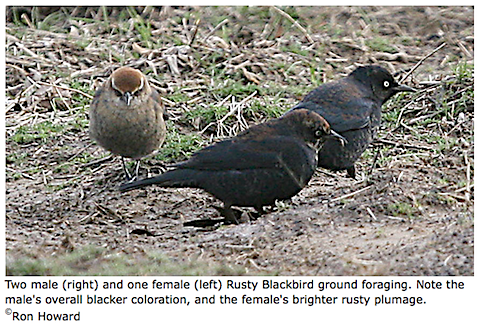Today is Birds and Beers at Joe's Garage--hopefully we'll see some hot crow action coming to the roost (if it hasn't shifted too far west) but at the very least, it's a great place with great food and beverages to meet other people interested in birds.
In the meantime, if anyone sees any rusty blackbirds between now and February 15 they need to be reported! It's the Second Annual Rusty Blackbird Blitz led by the eBirdprogram led by the Cornell Lab of Ornithology and theNational Audubon Society with additional coordinated by the International Rusty Blackbird Technical Working Group at the Smithsonian Migratory Bird Center.
The population of North American Rusty Blackbirds has plummeted an estimated 85 to 99 percent over the past 40 years. Although the exact cause for this decline is not clear, loss of habitat is one likely reason. Data gathered during the blitz will be used to create a map of wintering Rusty Blackbird "hot spots" and will help focus research, monitoring, and conservation efforts.
"We're looking for date, location, the time you began each survey, how long you were birding, and how far you traveled," said eBird co-leader Brian Sullivan. "It's important to submit your observations even if you don't see any Rusty Blackbirds. Negative data are incredibly valuable and still tell us a lot."
The focus of the blitz is on states that are known to be part of the Rusty Blackbird's winter range in bottomland wooded-wetlands, primarily in American midwestern and southeastern states: Alabama, Arkansas, Delaware, Florida, Georgia, Illinois, Indiana (yo, Mom, that's you--how about you, Aunt Lynne, and Aunt Lorelei go looking for some), Iowa, Kansas, Kentucky, Louisiana, Maryland, Mississippi, Missouri, New Jersey, North Carolina, Ohio, Oklahoma, Pennsylvania, South Carolina, Tennessee, Texas (east), Virginia, and West Virginia.
So, what does a rusty blackbird look like in winter? Like this:

If you go to the Rusty Blackbird eBird page (that's where the above photo came from) they give information on how to collect the info, photos of rusty habitat, and various photos of what rusty blackbirds look like so you can learn how to tell them apart from grackles and Brewer's blackbirds.
